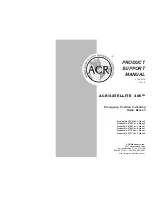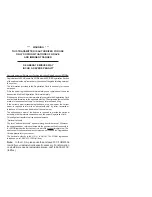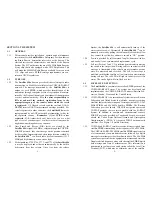
SECTION 1 - THE SYSTEM
1.1
GENERAL
1.1.1
This manual provides installation, operation and maintenance
instructions for the
Satellite 406
TM
Emergency Position Indicat-
ing Radio Beacon, hereinafter referred to as the Beacon. This
section describes the characteristics and details of the Beacon
System. The FCC authorizes the use of 406 MHz Radio Beacons
by any ship that is also equipped with a VHF Ship Station. This
will make the 406 MHz Radio Beacon available for use on most
U.S. ships and boats. EPIRB carriage requirements are con-
tained in USCG regulations.
1.2
PURPOSE
1.2.1
The
Satellite 406
TM
Beacon provides distress alerting via radio
transmission on 406 MHz to satellites of the COSPAS-SARSAT
network. The message transmitted by the
Satellite 406
TM
is
unique for each EPIRB, which provides identification of the
transmitter through computer access of registration files main-
tained by the National Oceanic and Atmospheric Administration
or other national authority.
It is the users responsibility to
fill out and mail the enclosed registration form to the
appropriate agency of the country under which the vessel
is registered.
US flagged vessels send the enclosed NOAA/
NESDIS form to NOAA in the stamped envelope provided. For
vessels registered in other countries, the
Satellite 406
must be
reprogrammed by an ACR authorized programming facility for
the registered country.
Remember
, if your EPIRB in
not
registered
, SAR Authorities do not know who you are, what
type of vessel, your home port, or where to contact anyone who
might know anything about your situation.
1.2.2
Once Search and Rescue (SAR) forces are alerted by the
Satellite 406
TM
signal (406 MHz), relayed through the COSPAS-
SARSAT network, they can converge on the position estimated
by the satellite. Intermediate and short range location is aided by
the
Satellite 406
TM'
s on board radio beacon transmitter (121.5
MHz) and high intensity xenon strobe light.
1.2.3
Model numbers 2754, 2756, 2772, and 2773 of the
Satellite 406
TM
may be deployed and activated automatically by the built-in
hydrostatic float free release. Once free from the release
bracket, the
Satellite 406
TM
will automatically turn on if the
water sensors are wet. Alternately, the
Satellite 406
TM
can be
manually activated by pulling the red lanyard to break the yellow
key, remove the yellow key and move switch to ON position.
1.2.4
Power is provided by self contained long life batteries with five
and one half year recommended replacement cycle.
1.2.5
Self test (Section 3.2 and 3.3) is initiated by momentarily moving
the switch to the test position. During self test, an actual satellite
message is transmitted while certain key performance param-
eters are measured and recorded. The self test message is
modified such that the satellite will not forward an alert message
during self test. The red LED will light to indicate correct test
status. The strobe light will also flash as a test.
1.3
SATELLITE DETECTION
1.3.1
The
Satellite 406
TM
constitutes the satellite EPIRB portion of the
COSPAS-SARSAT System. The system was developed and
implemented by the COSPAS-SARSAT Partners (Russian Fed-
eration, Canada, France and the United States).
1.3.2
COSPAS-SARSAT is an international system that uses Russian
Federation and United States low altitude, near-polar orbiting
satellites that assist in detecting and locating activated 121.5/243
MHz EPIRBs and 406 MHz Satellite EPIRBs. The Russian
Federation provides aboard COSMOS navigation spacecraft
COSPAS payloads that are inter-operable with the SARSAT
System. In addition to weather and environmental sensors,
SARSAT payloads, provided by Canada and France, are carried
aboard the United States National Oceanic and Atmospheric
Administrations (NOAAs) Advanced TIROS environmental
satellites. (See Figure 1: Satellite Detection)
1.3.3
COSPAS and SARSAT satellites receive distress signals from
satellite EPIRBs transmitting on the frequency of 406.025 MHz.
The COSPAS-SARSAT 406 MHz satellite EPIRB signal consists
of a transmission of non-modulated carrier followed by a digital
message format that provides identification data. The 406 MHz
system uses spacecraft-borne equipment to measure and store the
Doppler-shifted frequency along with the satellite EPIRB digital
data message and time of measurement. This information is
transmitted in real time to an earth station called the Local User
Terminal (LUT), which may be within the view of the satellite,
- 1 -
- 2 -




























